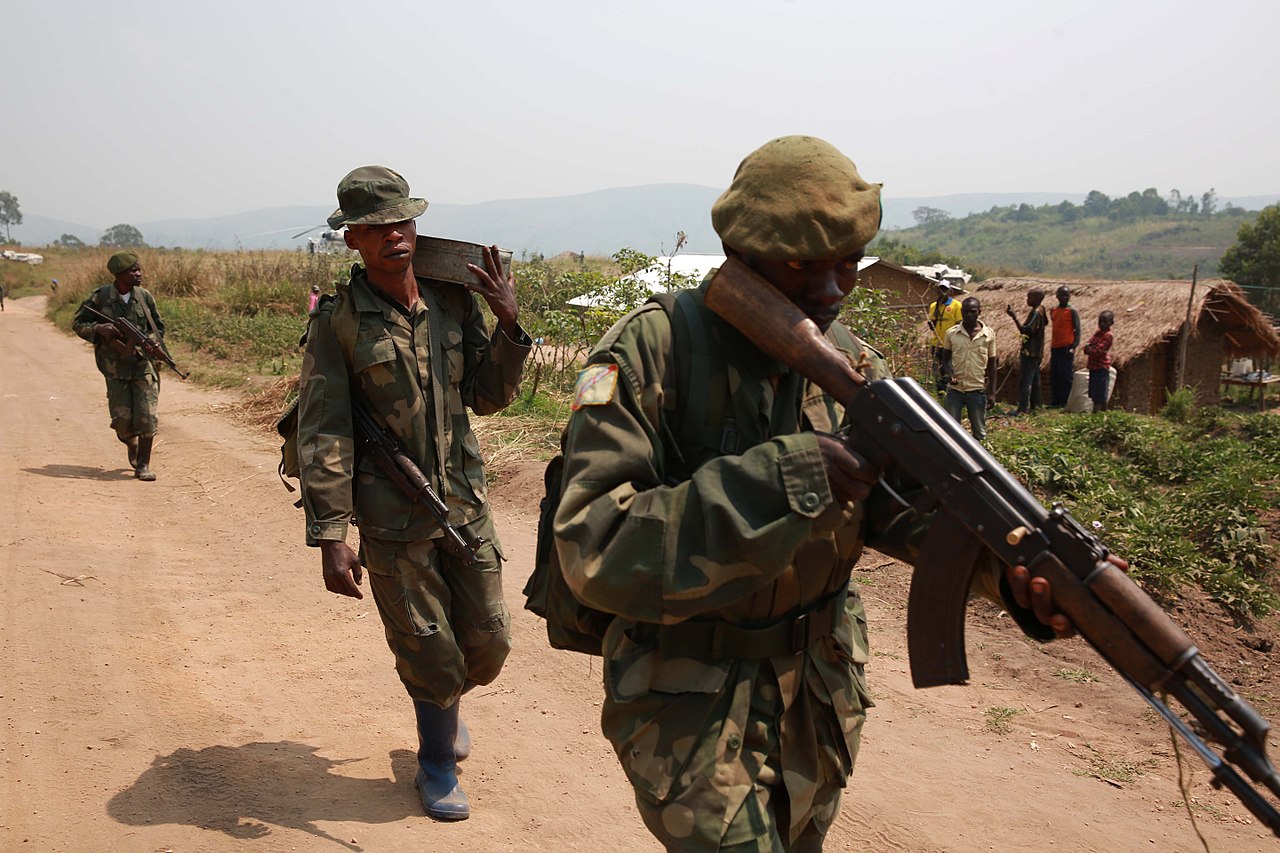“Capitalist society is and has always been horror without end.” - Lenin, 1916
Recent months have seen an intensification of the ongoing conflict in eastern Congo, which has unleashed a wave of death and destruction, forcing more than 1.5 million people from their homes since January.
Goma, the provincial capital of North Kivu province, has been almost completely encircled by the ‘M23’ rebel group, which began a series of offensives in late 2021. Conditions inside the city and the surrounding refugee camps have become unbearable. Millions of people are now trapped, facing extreme overcrowding, hunger, and the constant threat of bombardment.
The situation is now “at a breaking point”, according to the World Food Programme, with an estimated 23.4 million people facing starvation.
Further, the threat of escalation into a full-blown war between the Democratic Republic of the Congo (DRC) and neighbouring Rwanda, as well as the presence of soldiers from a host of other African states, carries the prospect of a regional war with horrifying implications for the people of the Congo and the entire continent.
But the source of this crisis lies far beyond the African Great Lakes. This never-ending cycle of plunder, displacement and death lies at the very heart of the capitalist world market, and is the direct product of more than a century of imperialist interference in the region.
Genocide and war
The roots of current conflict are to be found in the Rwandan genocide and ‘Congo Wars’ of the 1990s.
Under colonial rule, European imperialism carried out a consistent policy of ‘divide and rule’ throughout Africa. In Rwanda and Burundi, the imperialists rested on the pre-existing Tutsi elite, reinforcing its rights over the lands and lives of the largely Hutu peasantry, whilst elevating all Tutsis to the status of a fictitious ‘superior race’.
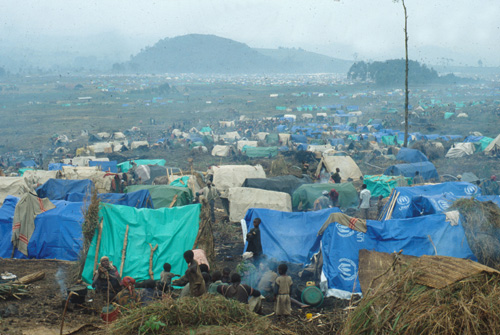 The Rwandan Civil War began in 1990, culminating in the Rwandan genocide of 1994 / Image: public domain
The Rwandan Civil War began in 1990, culminating in the Rwandan genocide of 1994 / Image: public domain
On independence in the 1960s, the entire continent was deliberately broken up into an unstable patchwork of weak capitalist states held in a state of backwardness, each with competing interests and territorial claims against their neighbours, and each therefore dependent on the major powers in order to pursue their own ambitions and intrigues.
In Central Africa, such a piling up of local conflicts and imperialist machinations would eventually produce some of the most horrifying events that humanity has witnessed since the Second World War.
The Rwandan Civil War began in 1990, when an army of Tutsi exiles called the Rwandan Patriotic Front (FPR) invaded Rwanda from Uganda, a US ally. This culminated in the Rwandan genocide of 1994, when the French-backed Hutu regime murdered almost 1 million Tutsis and moderate Hutus.
The victory of the FPR and overthrow of the Hutu nationalist regime in Kigali brought an end to the war in Rwanda, but only marked the prelude to an even bloodier conflict. The defeated genocidaires fled across the border into eastern Congo (then Zaire), along with up to 2 million Hutu refugees.
The Rwandan army then followed the genocidaires into Zaire, invading the country twice in 1996 and 1998, alongside Uganda, Burundi and other African allies. As they advanced through the country, the allies armed proxy groups along ethnic lines. M23 would eventually emerge from one of these proxies.
As the war went on, it degenerated further and further into a desperate scramble for loot, with Rwanda and Uganda eventually fighting each other on Congolese soil over possession of gold and diamond mines.
Barbarism has a logic of its own. Threatened by marauding troops from foreign armies or their Congolese proxies, tribal and ethnic groups throughout eastern Congo armed themselves and set up self-defence militia, known as Mai-Mai. But this defensive action was quickly transformed into violent raids on neighbouring groups for land, cattle and goods for the world market, such as cocoa, gold and diamonds, which were then smuggled out of the country.
M23
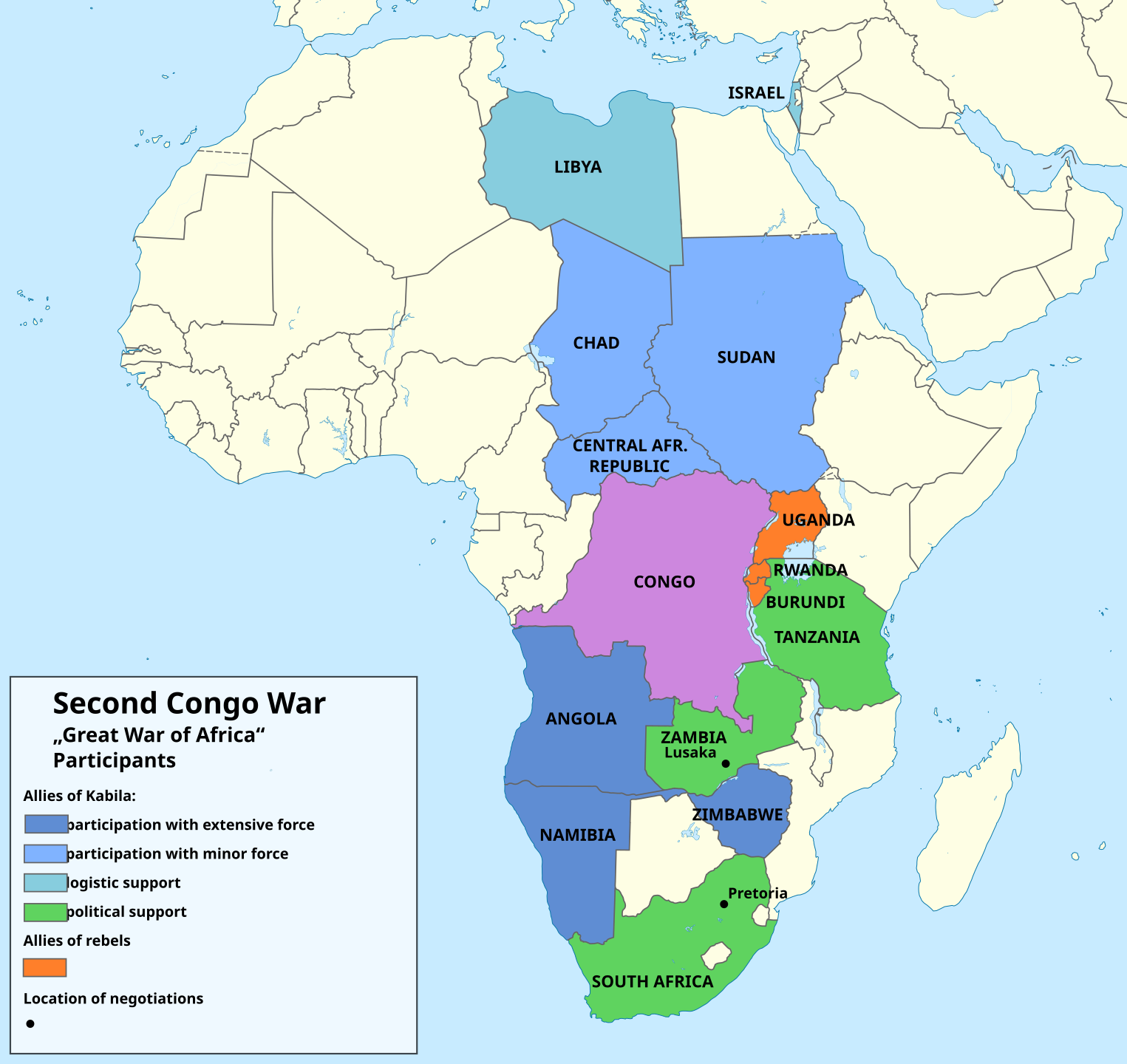 By the time the Second Congo War formally came to an end in 2003, a total of nine African nations had been dragged into the conflict / Image: Don kun, Wikimedia Commons
By the time the Second Congo War formally came to an end in 2003, a total of nine African nations had been dragged into the conflict / Image: Don kun, Wikimedia Commons
By the time the Second Congo War formally came to an end in 2003, a total of nine African nations had been dragged into the conflict, and an estimated 5.4 million people had been killed.
The country had been devastated, and the Congolese state (renamed to the Democratic Republic of the Congo) was in no position to disarm the various armed groups that had sprung up during the war. Instead, as part of the peace process, militias were simply ‘integrated’ into the Congolese army, only to break away and rebel the moment their commanders felt they were being cheated out of their share of the loot.
Often, these rebellions were supported directly by the DRC’s neighbours. This is the origin of M23, or the ‘March 23 Movement’. M23’s name refers to a peace treaty, signed on 23 March 2009 by the Congolese state and the National Congress for the Defence of the People (CNDP), a largely Tutsi group with strong links to the Rwandan government.
Under the terms of this treaty, CNDP fighters were to be integrated into the Armed Forces of the DRC (FARDC), but in 2012 the group revolted, claiming that the government had failed to hold up its side of the bargain. The group rebranded itself as ‘M23’, and then launched an offensive which took over Goma, the provincial capital of North Kivu, which borders Rwanda.
A UN report at the time presented overwhelming evidence that M23 was receiving substantial support from both Rwanda and Uganda. But having taken Goma, M23’s offensive rapidly went into reverse.
In 2013, the US and its allies began to cut aid to Rwanda, which then pulled its support. M23 surrendered unilaterally to Congolese and UN troops in November that year and its remaining fighters fled into the mountains, where they had lain dormant until a few years ago.
The terror of the market
Since the collapse of M23 in 2013, the violence in eastern DRC has continued unabated. Up to 600,000 people have been killed since 2003, while more than 120 armed groups have continued to subject the people of eastern Congo to an endless reign of terror. This terror persists for the simple reason that it is profitable. The logic of barbarism has been intertwined with the laws of the world market.
The DRC possesses an abundance of natural resources within its borders. The value of its untapped deposits of minerals, such as gold, diamonds and cobalt (used in the production of batteries for electric vehicles) is estimated at $24 trillion.
The DRC is also home to more than 70 percent of the world’s coltan, which is processed into tantalum, a metal used in electronic devices such as mobile phones, laptops and modern military equipment.
The rising demand for these minerals is met by as many as 2 million ‘artisanal’ miners – individuals, including children of seven years old, digging shoddy pits with picks, shovels, and their bare hands.
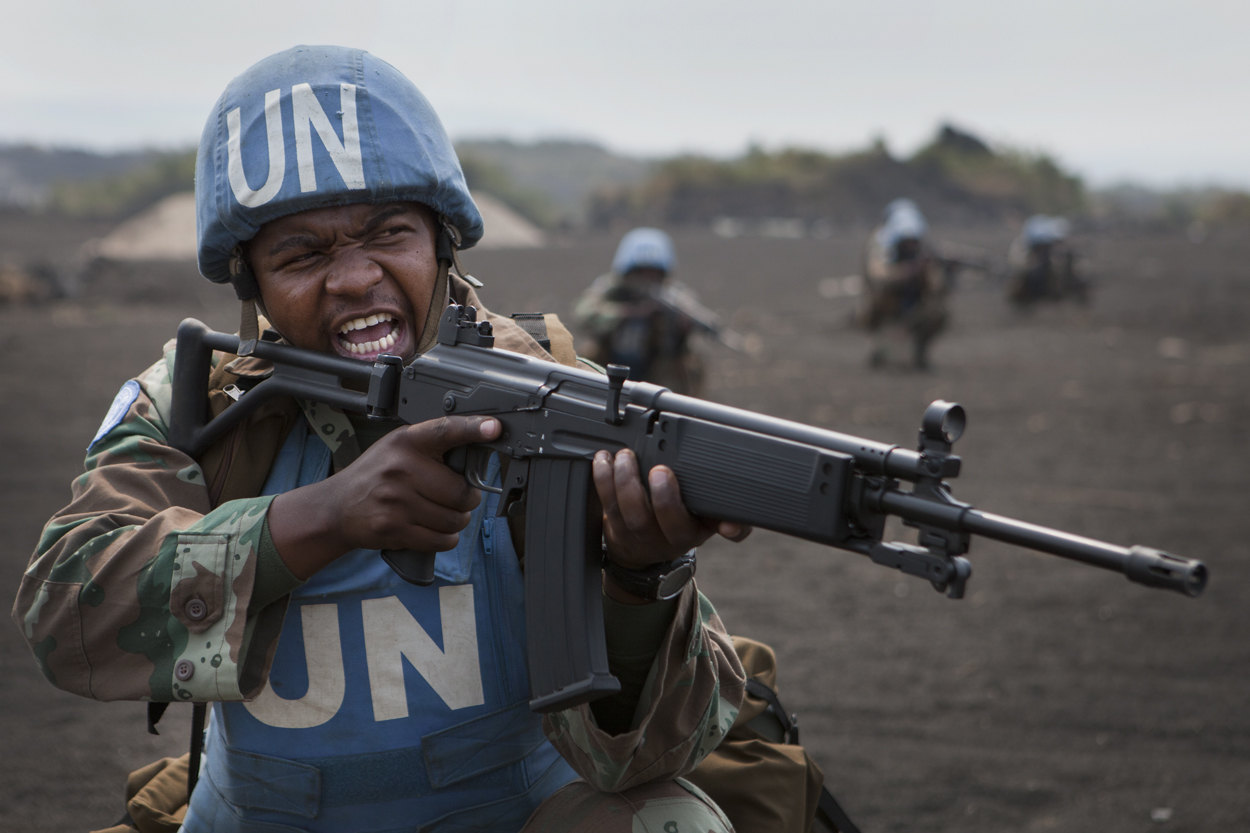 M23 surrendered unilaterally to Congolese and UN troops in November 2013 / Image: MONUSCO, Wikimedia Commons
M23 surrendered unilaterally to Congolese and UN troops in November 2013 / Image: MONUSCO, Wikimedia Commons
The miners, known as creuseurs, or the pit owners, sell the ore to middlemen called negociants who transport it to the nearest cities, such as Goma. There they sell it on at a higher price to traders, or comptoirs, usually financed by foreign backers, who then sell it on for processing elsewhere.
These veins of ever-flowing wealth are tapped at every point by the swarm of armed gangs that infest the region. Sometimes, they force the local population to dig at gunpoint. But in the majority of cases they simply stand above ground, ready to take a slice of the product in return for ‘protection’, or establish checkpoints on the roads for the same purpose.
Of all the armed groups active in eastern Congo, the most rapacious is arguably the Congolese army itself, whose troops are often indistinguishable from the other militias, and regularly dissolve into them if there are better prospects for the acquisition of wealth.
Militias like the Mai-Mai are mere mosquitos compared to the neighbouring states of Rwanda, Uganda, and to a lesser extent Burundi, which have continued to leech wealth out of eastern Congo ever since the outbreak of the Congo Wars in 1996.
More than 90 percent of the gold mined in the DRC is smuggled to neighbouring countries, which then export it to international buyers. In 2020, the most important export from both Rwanda and Uganda was gold, in spite of the low level of gold production in those countries.
Coltan has also become a pillar of the Rwandan economy. Even before the recent M23 offensive, in 2014, 2015, 2017, and 2019, Rwanda officially exported more coltan than the DRC. But according to the Ecofin Agency, around 90 percent of the coltan exported by Rwanda actually comes from artisanal mining in eastern Congo.
But, in truth, the plunder of the Congo by its neighbours is nothing compared to the profits squeezed out of the region by foreign imperialism. Similar to the negociants and comptoirs, the capitalists of Uganda and Rwanda are little more than middlemen for buyers in the most advanced economies on earth.
The three biggest tantalum refiners in the world are located in China, the USA, and Germany. These major refiners all obtain smuggled coltan from Rwanda, where it is cleared as ‘conflict free’, and then sell processed tantalum to the big tech companies, such as Apple, Huawei, and Nvidia.
Within this delicate ecosystem of exploitation, local conflicts between the various ‘self-defence’ groups, rivalries and outbreaks of violence between the petty states of the region, and competition between the big imperialist predators are inevitable. This is where we can trace the origins of the current war in eastern Congo.
Regional rivalries
For several years an equilibrium had been established between the states in the region, whereby they could all continue to syphon wealth out of eastern Congo without the need to escalate the conflict. This did not mean respite from the daily horror of child labour and the mafia methods of the local armed groups experienced by the people of the region. But it was an equilibrium, of sorts.
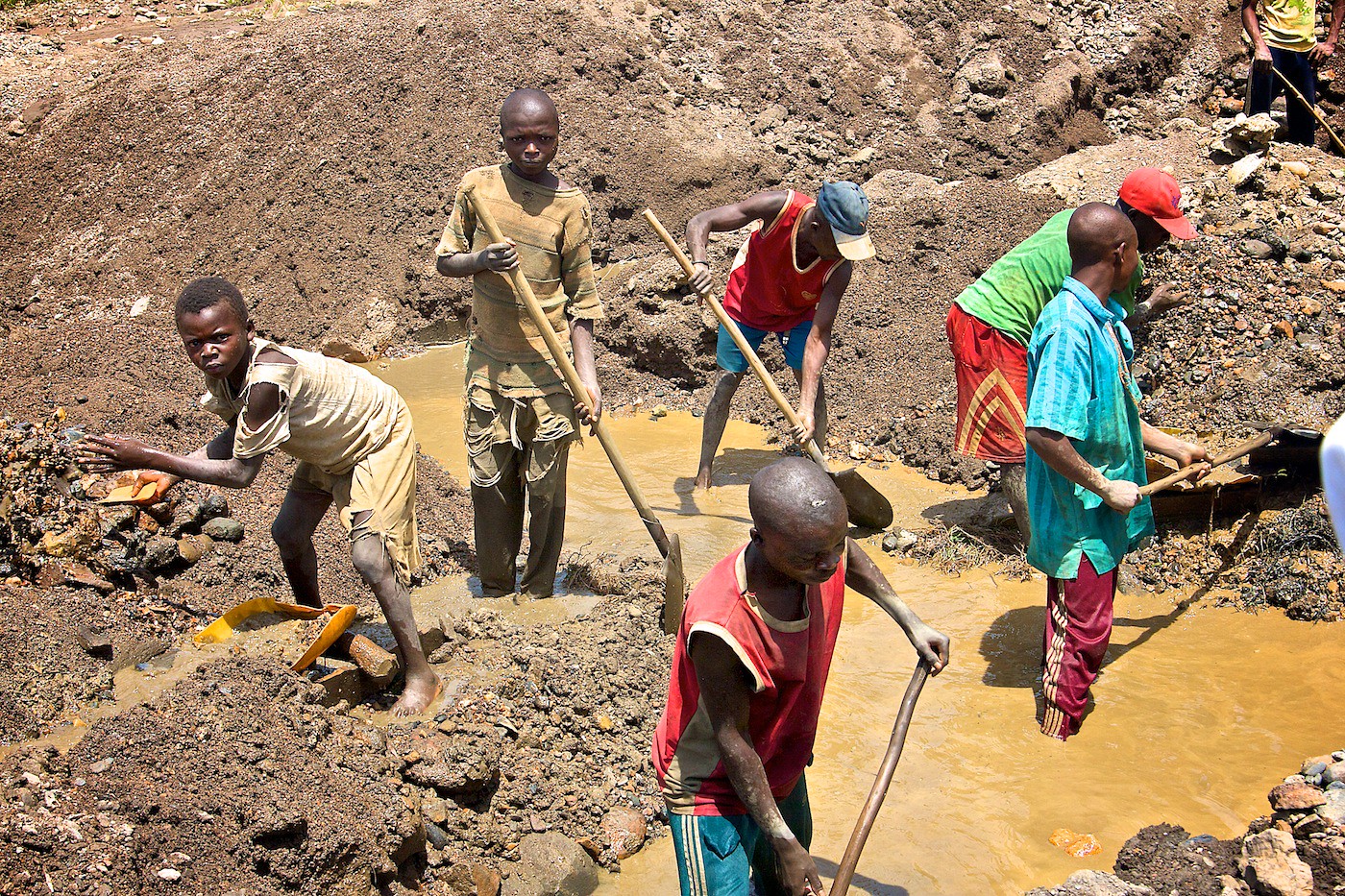 This did not mean respite from the daily horror of child labour / Image: Enough Project, Flickr
This did not mean respite from the daily horror of child labour / Image: Enough Project, Flickr
M23 re-emerged at the same time that this equilibrium began to break down amid important shifts in the DRC, in the rivalries between its neighbouring states, and in the competition between the major imperialist powers.
From around 2008, the DRC had come increasingly under the influence of China, which began to invest heavily in the country’s mining sector. Chinese investment was particularly focused on cobalt, which the Chinese ruling class had identified as of strategic importance due to its use in the manufacture of batteries for electric vehicles.
Today, Chinese companies control 15 of the DRC’s 19 cobalt mines, largely located in the south of the country. As much as 95 percent control of the global supply of refined cobalt products is now under Chinese control. This presents a significant threat to the interests of US imperialism, which is in competition with China for domination of the global EV market.
From the beginning of 2019, the United States began a renewed ‘charm offensive’ in Africa, with the intention of pushing back Chinese influence on the continent. In the DRC, this took the form of establishing a “privileged partnership” with President Felix Tshisekedi, who had just come to power in what was widely known to be a rigged election.
Tshisekedi’s first trip outside of Africa was to the USA, where he secured a $600 million aid deal. The IMF then approved a further $1.52 billion for the DRC, on the condition that the state review its mining contracts with mostly Chinese firms.
Encouraged by the US, Tshesekedi then carried out a power grab. Up until this point, Tshisekedi had ruled in coalition with supporters of his more China-aligned predecessor, Joseph Kabila, who retained the majority in parliament. But in December 2020 Tshisekedi openly broke with Kabila’s coalition, buying the loyalty of Kabila’s supporters in parliament and the military with lucrative positions in the state.
Meanwhile, the situation in the east was becoming increasingly unstable. Armed attacks on civilians had begun to increase steadily after Kabila suspended elections in 2016, and the violence escalated further after the COVID-19 pandemic struck in 2020.
In May 2021, Tshisekedi placed the eastern provinces of Ituri, North Kivu, and South Kivu under a ‘state of siege’, meaning the military governors of the province now had complete powers to rule each province as their own. But the number of attacks actually rose under the state of siege.
Around the same time, Tshisekedi was trying to make deals with his neighbours in Uganda, Rwanda, and Burundi. At the beginning of his presidency he had invited all three of his eastern neighbours to collaborate in a joint force to fight a number of rebel groups in eastern Congo.
Tshisekedi’s proposal was rejected by all parties because they were supporting several of these rebel groups against each other, so the prospect of fighting their own proxies wasn’t very appealing. He then started to sign agreements separately with each of these rival countries. This gamble backfired spectacularly.
In June 2021, Tshisekedi signed a cooperation agreement with Rwanda, giving it rights over gold refining, which Uganda objected to. Then, in October that year, he signed a memorandum of understanding with Uganda on joint operations in the DRC, as well as an infrastructure programme. He also established formal military cooperation with the Burundian military, which is hostile to Rwanda.
This represented a major threat to Rwandan interests in the region. In particular, the plan for a major road-building project, linking eastern Congo to Uganda, threatened to pull the flow of minerals away from Rwanda. The joint DRC-Uganda operation, named ‘Shujaa’, commenced in November 2021. M23 began to attack Congolese positions that same month.
Weakness of the West
M23’s initial attacks were on a small scale and easily repelled. The turning point came in March 2022, when M23 launched an offensive that by mid-2022 had captured the largest military base in North Kivu and reached the outskirts of Goma. Its rapid advance was due to direct military support from Rwanda.
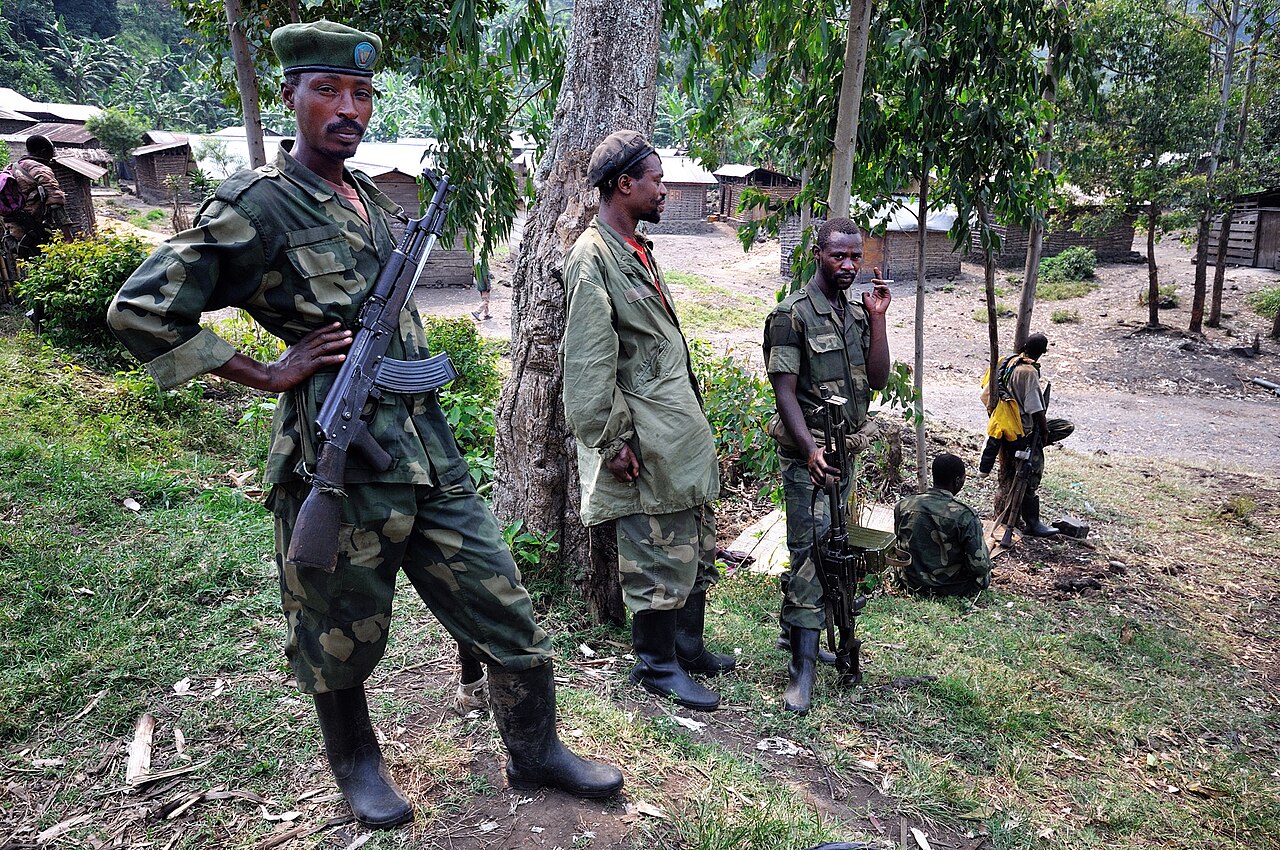
M23 is much better armed than any of the other armed groups fighting in eastern Congo. It has heavy artillery and has also proved capable of using it. Further, a recent UN report has confirmed that 3,000-4,000 troops from the Rwandan army are actively fighting alongside M23, which the UN report described as being under the “de facto control” of Rwanda.
As the conflict continues, public opinion in the DRC is becoming more and more hostile to the USA and the West, who are seen, with reason, as enabling Rwanda’s invasion. Tshisekedi himself has pointed out the hypocrisy of the so-called ‘international community’, comparing the present situation with the war in Ukraine:
“We will only be satisfied when the Security Council imposes sanctions on Rwanda. When Russia did the same thing, there was a flurry of sanctions. For a case similar to that of Russia and Ukraine, why is there not a single sanction? To me, they can do better.”
But at the same time he has been trying to present himself as an African Zelensky to the West, Tshisekedi has agreed a draft military cooperation agreement with none other than Putin’s Russia.
The Congolese leader has also strengthened relations with China, which announced that it has upgraded its relationship with the DRC “from a win-win strategic cooperative partnership to a comprehensive strategic cooperative partnership".
The further M23 advances, the more likely it becomes that western imperialism will lose all of the influence that it had begun to rebuild in the DRC under Tshisekedi, at the cost of billions of dollars. It would be a heavy blow for the West both diplomatically and economically.
Accordingly, US diplomats have called for “peace” and “dialogue” between the DRC and Rwanda, and have recently “condemned” M23’s invasion, but they have been extremely slow to take any action, suspending military aid to Rwanda only in October, after the conflict had been raging for more than 18 months. Meanwhile, financial aid in various forms continues to flow into Rwanda, and no sanctions have been placed on the Rwandan president, Paul Kagame, in stark contrast to Putin.
Paul Kagame
Kagame has been an important US ally in the region since the end of the Rwandan civil war in 1994.
More than 40 percent of Rwanda’s state budget is covered by western aid; its army has been armed and trained by NATO; and the country even formally joined the British Commonwealth in 2009, despite never having been a British colony. To this day, major European football clubs, such as London’s Arsenal and Paris St Germain, play with ‘Visit Rwanda’ emblazoned on their shirts.
In the past, western imperialism has relied on the Kagame regime as one of the only stable regimes in the whole of Africa. The Rwandan army has even been deployed to other African nations, such as Mozambique and the Central African Republic, in return for generous aid packages and mining concessions, owned directly by the Rwandan military.
But now Kagame is carrying out a policy that threatens to destroy western influence in the DRC, and destabilise the entire region.
To understand this apparent contradiction it is necessary to look back at M23’s last major offensive, in 2012. At that time no rival to the US had either the strength nor the interest in backing Kagame and M23. US imperialism was thus able to rein in its ally, which was still rebuilding itself after years of war and genocide. Now, however, the situation is much more complicated.
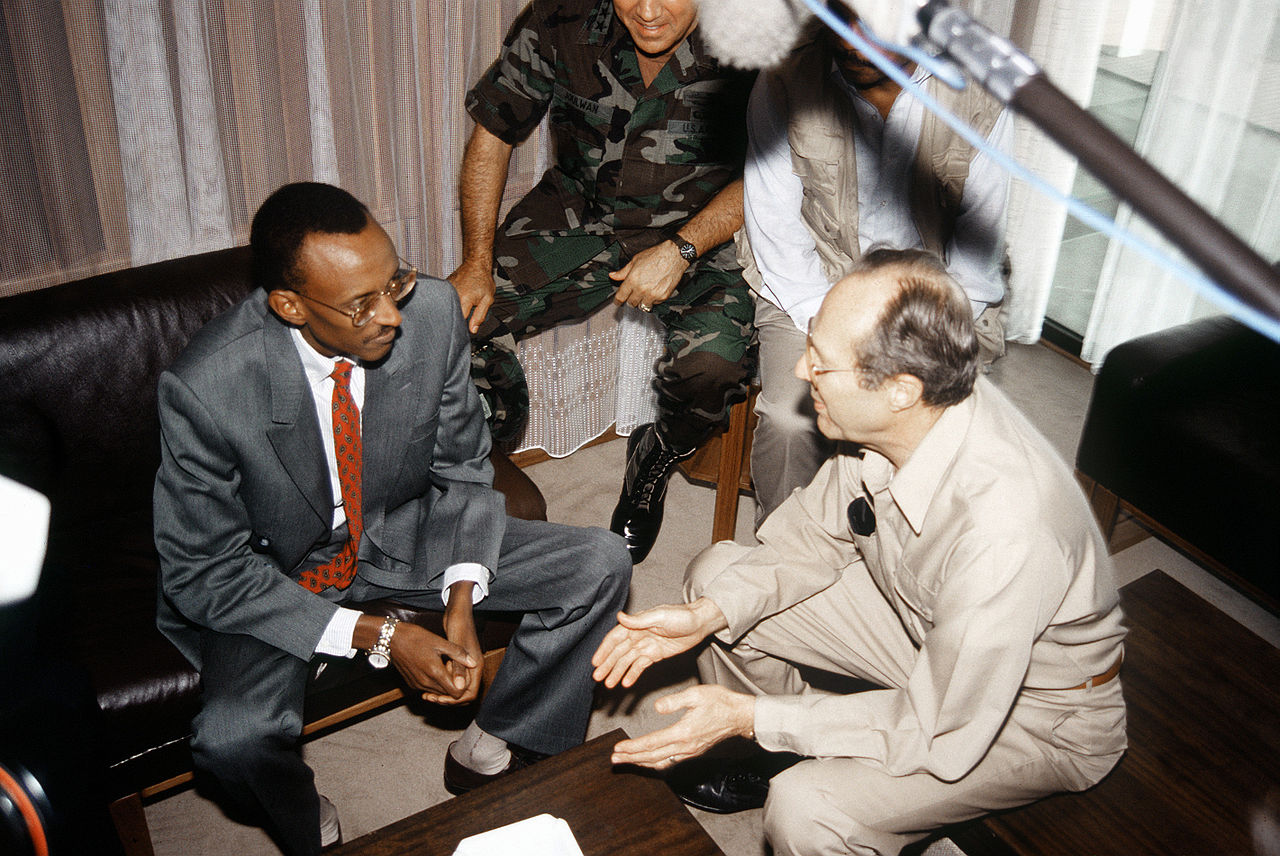 Kagame has been an important US ally in the region since the end of the Rwandan civil war / Image: public domain
Kagame has been an important US ally in the region since the end of the Rwandan civil war / Image: public domain
This is an existential question for Kagame. While he claims to stand for the protection of Rwandans and Congolese Tutsis against Hutu militias that operate in the DRC, his only priority is the stability of his own regime.
Last week’s election, which gave Kagame 99 percent of the vote, reflected not only the fact that all serious opposition had been banned, but also the level of passive acceptance of the regime that exists amongst ordinary Rwandans. Kagame’s rule is associated with economic growth and stability, compared to neighbouring states like Burundi and the DRC. But if this growth goes into reverse, the fault lines of the past will surely re-emerge.
Ultimately, the most far-sighted wing of the Rwandan ruling class, of which Kagame is the head, aims at establishing Rwanda as a ‘middle income’ country by the year 2035, no longer dependent on foreign aid, and therefore able to assert itself as a regional power. But the road to this independence lies through the mountains of eastern Congo.
If the West places heavy sanctions on Rwanda, as they did on Russia, Kagame will not meekly withdraw; he will seek financial and military assistance from the West’s rivals, who have shown they now have the means to assert themselves in formerly western spheres of influence.
If, for example, the so-called ‘international community’ were to ban the import of minerals from Rwanda, as it did with Russian oil, other powers would be happy to step in and fill the gap, just as countries like China, India and Turkey have done for Russia. In fact, India is now the top foreign investor in Rwanda, with the United Arab Emirates (UAE) in second place.
But it is not just western imperialism that stands to lose in this conflict. China has also been very tentative in its support for its Congolese ‘friends’. So far it has sent six drones, of which several have already been destroyed. At the same time, it sent the Rwandan state $35 million in interest-free loans when Western donors began to pull back.
The reason for this is that China is a major buyer of minerals from Rwanda as well as the DRC, and so would like to maintain stable relations with both countries. However, this is becoming increasingly difficult.
Therefore, what we are seeing is not a straightforward proxy war between the USA and China, but a precarious balancing act, in which the major powers are trying to maintain points of support amongst all sides in the conflict, while the smaller players are circling each other, attempting to gain a decisive advantage. This is the real meaning of ‘multi-polarity’ today.
What this means for the situation in eastern Congo is that Kagame is calling the West’s bluff, similar to Netanyahu in Israel, estimating that the western powers need him even more than he needs them.
At the same time, it is noteworthy that for all its successes, M23 has not even attempted to seize Goma directly, unlike in 2012. It may well be that Kagame has learned his lesson since then, preferring to take control of a wide swathe of territory in order to use it as a bargaining chip in future negotiations, rather than risk polarising the conflict to such a degree that the major powers are compelled to intervene more forcefully.
But the situation could easily slip out of anyone’s control.
On the brink
All of the factors that led to the Congo Wars are currently present in the region. A single event, even an accident, could spark a new regional conflagration. And perhaps the most unstable element in the whole situation is the Congolese state itself.
The political, social and diplomatic situation in the DRC has deteriorated rapidly. Mass protests have erupted against the UN mission in the country, called ‘MONUSCO’, which is accused of allowing rebel groups to act with impunity. This rage spilled over in July 2022, when protestors seized weapons from the police and attempted to storm UN facilities, resulting in the deaths of 36 people.
In November 2022, Tshisekedi called for the formation of “vigilance groups” to fight against M23. This was eventually formalised as the ‘Wazalendo’ (‘patriots’ in Swahili), a constantly shifting network of Mai-Mai self-defence groups and other militias, some of whom the army had been fighting only months before. For example, the ‘Democratic Forces for the Liberation of Rwanda’ (FDLR), founded and led by Hutu genocidaires from Rwanda, is now reported as collaborating with both the Wazalendo and Congolese generals.
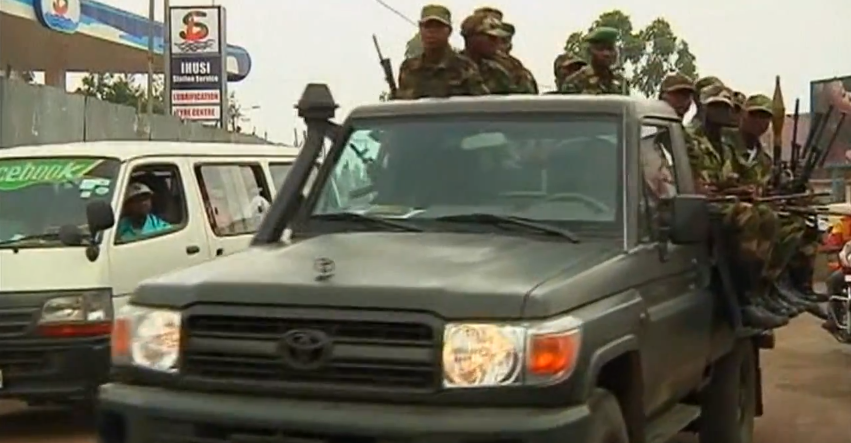 M23 continued to advance throughout 2023 / Image: public domain
M23 continued to advance throughout 2023 / Image: public domain
In spite of this initiative, M23 continued to advance throughout 2023. The Wazalendo are poorly trained and undisciplined, and tend to remain in their own areas, as is their nature as self-defence groups. The fact that the Congolese army has effectively been fused with these militias in the east betrays its own state of weakness and disorganisation. Meanwhile, the relocation of units to fight M23 has freed up other groups to carry out attacks elsewhere.
In the run up to new elections in December 2023, Tshisekedi claimed he would declare war on Rwanda as a means of rallying support around himself. Linked to this, anti-Tutsi propaganda has become increasingly prominent, presenting all Tutsis in the DRC as Rwandans, essentially an ‘enemy within’. This has only helped Kagame present himself as the defender of all Tutsis.
Tshisekedi has also turned to a number of different regional powers for support, pulling more and more nations into the conflict. First he turned to the East African Community (of which Rwanda is a part). Disappointed, he has now turned to the South African Development Community, which has pledged a force of 4,800 troops. South African and Tanzanian soldiers have already been killed by M23, if not by Rwandan troops directly.
This constant shifting of alliances in all directions reflects the instability and disintegration taking place within the DRC. “We no longer know who commands whom, and the commanders are not in the field,” said a colonel, interviewed by Reuters. Earlier this month, 25 Congolese soldiers were sentenced to death for desertion. This gives an indication of the level of demoralisation within the army.
And while an amateurish coup attempt launched in May was a complete failure, it shows the potential for ambitious opportunists, particularly within the military, to strike if they get the chance.
It is not ruled out that the Congolese state could collapse even further, creating a vacuum that would drag all forces further into the melee. And as anti-Tutsi rhetoric piles up alongside tales of real atrocities committed by M23, the threat of mass reprisals against Congolese Tutsis, even on a genocidal scale, increases. Again, barbarism has a logic of its own.
World revolution
Capitalism has created a hell on earth for the people of eastern Congo, and so long as capitalism exists, their agony will continue. Any call for peace that avoids this fact is doomed to impotence.
Communists oppose the predatory war being waged by Rwanda, and condemn the intrigues of the imperialists who have prepared this crisis, above all in the USA and Europe. But the only way to bring an end to this nightmare is the overthrow of all the rotten capitalist regimes in the region by a revolutionary movement of the masses.
Only the sweeping away of the irrational borders imposed by imperialism and the establishment of a socialist federation can allow for genuine peace and development in Africa.
Only rapid economic development can provide the food, work, shelter, and healthcare that the people of the Congo desperately need. The resources for such a transformation are present in abundance, but only if they are seized by the workers and peasants of the region and developed as part of a democratic plan, not for the profits of the capitalist but for the needs of the population.
The potential for such a movement exists across Africa, where a revolutionary rage has built up amongst the masses. This rage could clearly be seen in the recent insurrectionary movement in Kenya.
In neighbouring Uganda, the 79-year-old Museveni is trying desperately to maintain the stability of his regime. On Tuesday, young Ugandans marched to parliament in Kampala in defiance of a police ban, enraged by the regime’s corruption and inspired by the movement in Kenya.
Within the DRC itself, the frustration of the masses against this never-ending exploitation, corruption and instability is palpable. A successful revolution in any one of these countries could mark the beginning of a new wave of revolutions across the continent.
But the revolution cannot be confined to Africa. Imperialism must be overthrown everywhere. What is required is a war on capital itself, in which the workers of every country will play the leading role. For the Congo and for the world, we must win.

